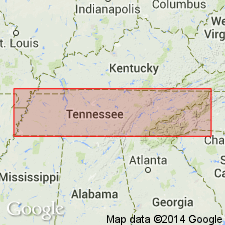
- Usage in publication:
-
- Kingsport formation
- Modifications:
-
- Named
- Dominant lithology:
-
- Dolomite
- Limestone
- AAPG geologic province:
-
- Appalachian basin
Summary:
Named the Kingsport formation for Kingsport, Sullivan Co., TN. Consists of (ascending), 1) 178 to 216 feet of mainly brown limestone locally altered to crystalline dolomite, interbedded with light to dark gray, fine-grained dolomite with numerous cherty layers, 2) 33 to 38 feet of light to dark gray and brownish, fine-grained to finely crystalline dolomite and some brown limestone, 3) 44 to 50 feet of light brownish gray to nearly white, fine-grained dolomite, some which is lithographic in texture, and 4) 101 to 135 feet of fairly light to dark, fine-grained dolomite with some interbedded brown limestone. Unit overlies the Longview formation and is separated from the overlying Mascot formation by a chert matrix sand about 6 inches thick. The Kingsport is of Early Ordovician age.
Source: GNU records (USGS DDS-6; Reston GNULEX).
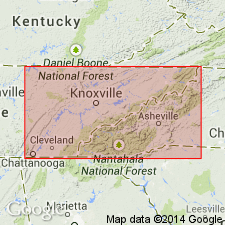
- Usage in publication:
-
- Kingsport dolomite*
- Modifications:
-
- First used
- AAPG geologic province:
-
- Appalachian basin
Summary:
Name Kingsport dolomite appears on map legend. Unit occurs below Mascot dolomite.
Source: GNU records (USGS DDS-6; Reston GNULEX).
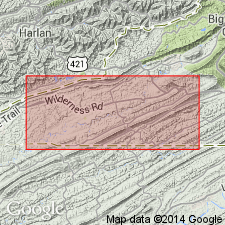
- Usage in publication:
-
- Kingsport dolomite*
- Modifications:
-
- Areal extent
- AAPG geologic province:
-
- Appalachian basin
Summary:
Geographically extended the Kingsport dolomite to southwestern VA. Unit overlies the Longview dolomite and underlies the Mascot dolomite. The Kingsport is 119 to 272 feet thick.
Source: GNU records (USGS DDS-6; Reston GNULEX).
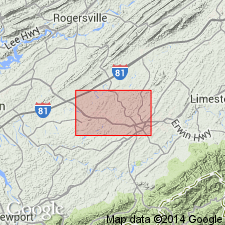
- Usage in publication:
-
- Kingsport Limestone*
- Modifications:
-
- Revised
- AAPG geologic province:
-
- Appalachian basin
Summary:
Revised the Kingsport to the Kingsport Limestone in eastern TN. Consists of blue and bluish-gray very fined-grained limestone in the lower third of the formation, and light gray, very fine-grained silty dolomite in the upper two-thirds. Formation is cherty throughout occurring as flattened nodules. The base of the Kingsport is placed at the bottom of the thick limestone overlying the Longview Dolomite, and the top of the formation is placed at the base of the lowest distinctive quartzitic sandstone of the overlying Mascot Dolomite. Thickness is about 230 feet. The Kingsport Limestone is of Early Ordovician age.
Source: GNU records (USGS DDS-6; Reston GNULEX).
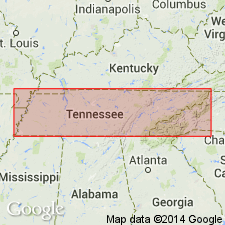
- Usage in publication:
-
- Kingsport Formation*
- Modifications:
-
- Revised
- AAPG geologic province:
-
- Appalachian basin
Summary:
Abandoned the Longview Dolomite in Tennessee and redefined the Kingsport Formation and Mascot Dolomite. Included the Longview in the Kingsport and lowered the upper contact of the Kingsport with the overlying Mascot. The Kingsport contains limestone and medium to coarse-crystalline dolomite; Mascot contains very finely crystalline dolomite (part of which used to be referred to Kingsport). The reason for this revision is that the original formations in the upper part of the Knox Group were divided by fossil content and were not readily mappable.
Source: GNU records (USGS DDS-6; Reston GNULEX).
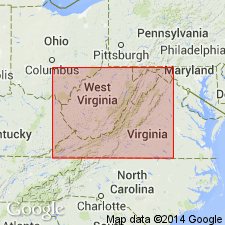
- Usage in publication:
-
- Kingsport Dolomite Member
- Modifications:
-
- Revised
- AAPG geologic province:
-
- Appalachian basin
Summary:
Reduced the rank of the Kingsport to a member of the Beekmantown Formation. Revision shows up on figure 3 for the southern Appalachian region but is not discussed in text. Unit overlies the Longview Member and underlies the Mascot Member of the Beekmantown Formation.
Source: GNU records (USGS DDS-6; Reston GNULEX).
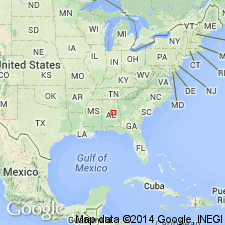
- Usage in publication:
-
- Kingsport Formation*
- Modifications:
-
- Overview
- Biostratigraphic dating
- AAPG geologic province:
-
- Appalachian basin
Summary:
The uppermost unit of the Sylacauga Marble Group (Tull, 1982), the Gantts Quarry Formation of Tull (1985), contains Early Ordovician conodonts that confirm correlation with the Newala Limestone, Kingsport Formation, and Mascot Dolomite of the Appalachian foreland.
Source: GNU records (USGS DDS-6; Reston GNULEX).
For more information, please contact Nancy Stamm, Geologic Names Committee Secretary.
Asterisk (*) indicates published by U.S. Geological Survey authors.
"No current usage" (†) implies that a name has been abandoned or has fallen into disuse. Former usage and, if known, replacement name given in parentheses ( ).
Slash (/) indicates name conflicts with nomenclatural guidelines (CSN, 1933; ACSN, 1961, 1970; NACSN, 1983, 2005, 2021). May be explained within brackets ([ ]).

